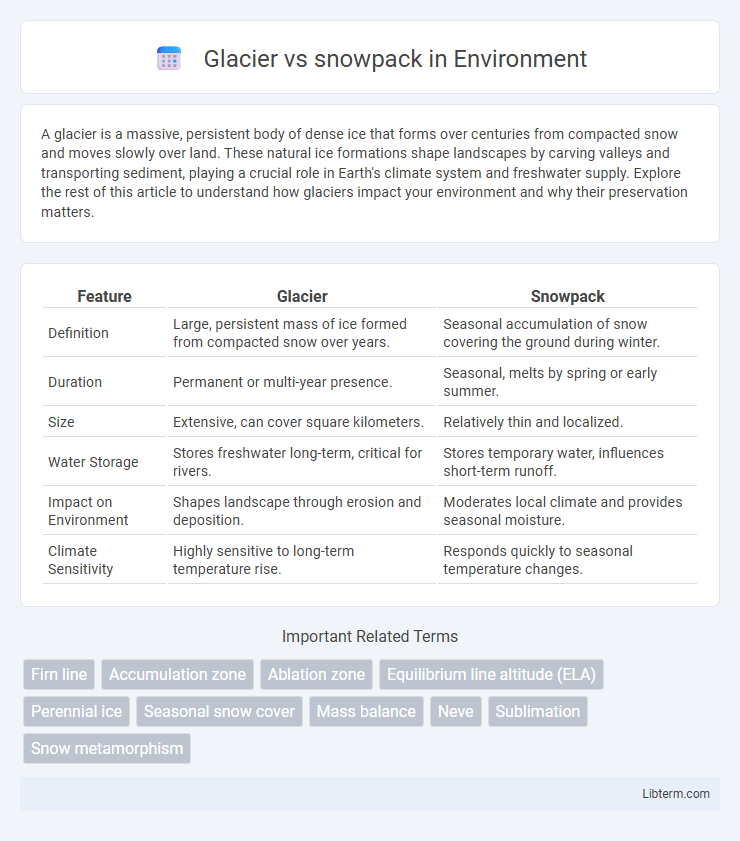A glacier is a massive, persistent body of dense ice that forms over centuries from compacted snow and moves slowly over land. These natural ice formations shape landscapes by carving valleys and transporting sediment, playing a crucial role in Earth's climate system and freshwater supply. Explore the rest of this article to understand how glaciers impact your environment and why their preservation matters.
Table of Comparison
| Feature | Glacier | Snowpack |
|---|---|---|
| Definition | Large, persistent mass of ice formed from compacted snow over years. | Seasonal accumulation of snow covering the ground during winter. |
| Duration | Permanent or multi-year presence. | Seasonal, melts by spring or early summer. |
| Size | Extensive, can cover square kilometers. | Relatively thin and localized. |
| Water Storage | Stores freshwater long-term, critical for rivers. | Stores temporary water, influences short-term runoff. |
| Impact on Environment | Shapes landscape through erosion and deposition. | Moderates local climate and provides seasonal moisture. |
| Climate Sensitivity | Highly sensitive to long-term temperature rise. | Responds quickly to seasonal temperature changes. |
Introduction to Glaciers and Snowpacks
Glaciers are massive, persistent bodies of dense ice that form over centuries from compacted snow and continuously flow under their own weight. Snowpacks consist of layers of seasonal snow accumulation that build up and melt within a year, playing a crucial role in water storage and runoff in mountainous regions. Understanding the differences between glaciers and snowpacks is essential for assessing long-term climate impact and freshwater resource availability.
Formation Processes of Glaciers
Glaciers form through the gradual accumulation and compaction of snow over many years, transforming snowpack into dense, crystalline ice as pressure increases. Unlike seasonal snowpack, glaciers develop where snow persists year-round, allowing continuous recrystallization and ice flow under gravity. This long-term metamorphism distinguishes glacier formation from transient snowpack accumulation.
Formation of Snowpacks Explained
Snowpacks form through the accumulation and compaction of seasonal snowfall, primarily influenced by temperature fluctuations, solar radiation, and wind patterns. Layers of snow undergo metamorphism, where recrystallization processes create varying grain sizes and densities, affecting water retention and stability. Unlike glaciers, snowpacks are typically transient and seasonal, melting each year and playing a critical role in freshwater resources and avalanche risk in mountainous regions.
Key Differences: Glacier vs Snowpack
Glaciers are large, persistent bodies of dense ice that form over centuries through the accumulation and compaction of snow, while snowpack refers to the seasonal accumulation of snow that typically melts within months. Glaciers exhibit slow movement due to gravity and internal deformation, contributing to long-term water storage and shaping landscapes, whereas snowpacks primarily serve as temporary reservoirs influencing short-term water availability. The key difference lies in glaciers' permanence and dynamic flow compared to the transient and static nature of snowpacks.
Physical Characteristics Comparison
Glaciers are large, persistent bodies of dense ice that form over centuries through the accumulation and compaction of snow, characterized by their slow movement and significant thickness often exceeding tens to hundreds of meters. Snowpacks consist of seasonal snow layers that accumulate on the ground, typically less dense and more granular, with thicknesses varying greatly but generally much thinner than glaciers. While glaciers show distinct ice crystal structures and crevassing due to deformation, snowpacks remain relatively loose and stratified, melting completely during warmer months.
Climate Impact on Glaciers and Snowpacks
Glaciers and snowpacks respond differently to climate change, with glaciers showing long-term retreat and mass loss due to rising global temperatures, while snowpacks experience reduced accumulation and earlier melt seasons, affecting water availability. The decline in glacier volume contributes to sea-level rise, whereas diminished snowpack alters hydrological cycles critical for ecosystems and human water supply. Both changes reflect warming trends but impact regional climates and water resources in distinct yet interconnected ways.
Role in Regional Water Resources
Glaciers serve as long-term freshwater reservoirs, releasing meltwater steadily throughout the year, which sustains river flows during dry seasons and supports downstream ecosystems. Snowpack functions as a seasonal water storage, accumulating winter precipitation and melting in spring, feeding rivers and reservoirs critical for agriculture, hydropower, and drinking water. Together, glaciers and snowpack regulate regional water availability by buffering seasonal variability and mitigating drought impacts in mountainous watersheds.
Melting Patterns and Seasonal Changes
Glaciers exhibit year-round melting patterns with gradual ice loss influenced by long-term climate trends, while snowpack melting occurs seasonally, primarily during warmer months after winter accumulation. Snowpack melting is rapid and affects water runoff in spring and early summer, in contrast to glaciers which contribute to sustained meltwater flow over extended periods. Seasonal snowpack acts as a temporary water reservoir, whereas glaciers store multi-year ice that responds slowly to temperature variations.
Environmental and Ecological Impacts
Glaciers serve as long-term freshwater reservoirs, releasing meltwater gradually to sustain river ecosystems during dry periods, whereas snowpacks act as seasonal water sources but melt more rapidly, influencing short-term water availability and streamflow. The retreat of glaciers due to climate change disrupts downstream habitats by reducing cold-water inputs crucial for species like salmon, while diminishing snowpack levels lead to altered timing of water flow, affecting plant growth cycles and soil moisture. Glacial melt contributes to sea-level rise, impacting coastal ecosystems, whereas fluctuating snowpack causes variability in wildfire risk and nutrient cycling within mountainous regions.
Future Outlook: Glaciers and Snowpacks in a Warming World
Glaciers and snowpacks are both critical freshwater reservoirs highly vulnerable to rising global temperatures, with glaciers retreating at unprecedented rates and snowpack levels declining significantly across mid-latitude mountain ranges. Climate models predict continued warming will exacerbate glacier melt, leading to long-term reductions in ice mass and altered seasonal runoff patterns, while diminishing snowpack depth and duration threaten water supplies dependent on spring and summer melt. These changes impact ecosystems, agriculture, and human settlements relying on predictable snow and glacier-fed water flows, necessitating adaptive water management strategies in a warming world.
Glacier Infographic

 libterm.com
libterm.com